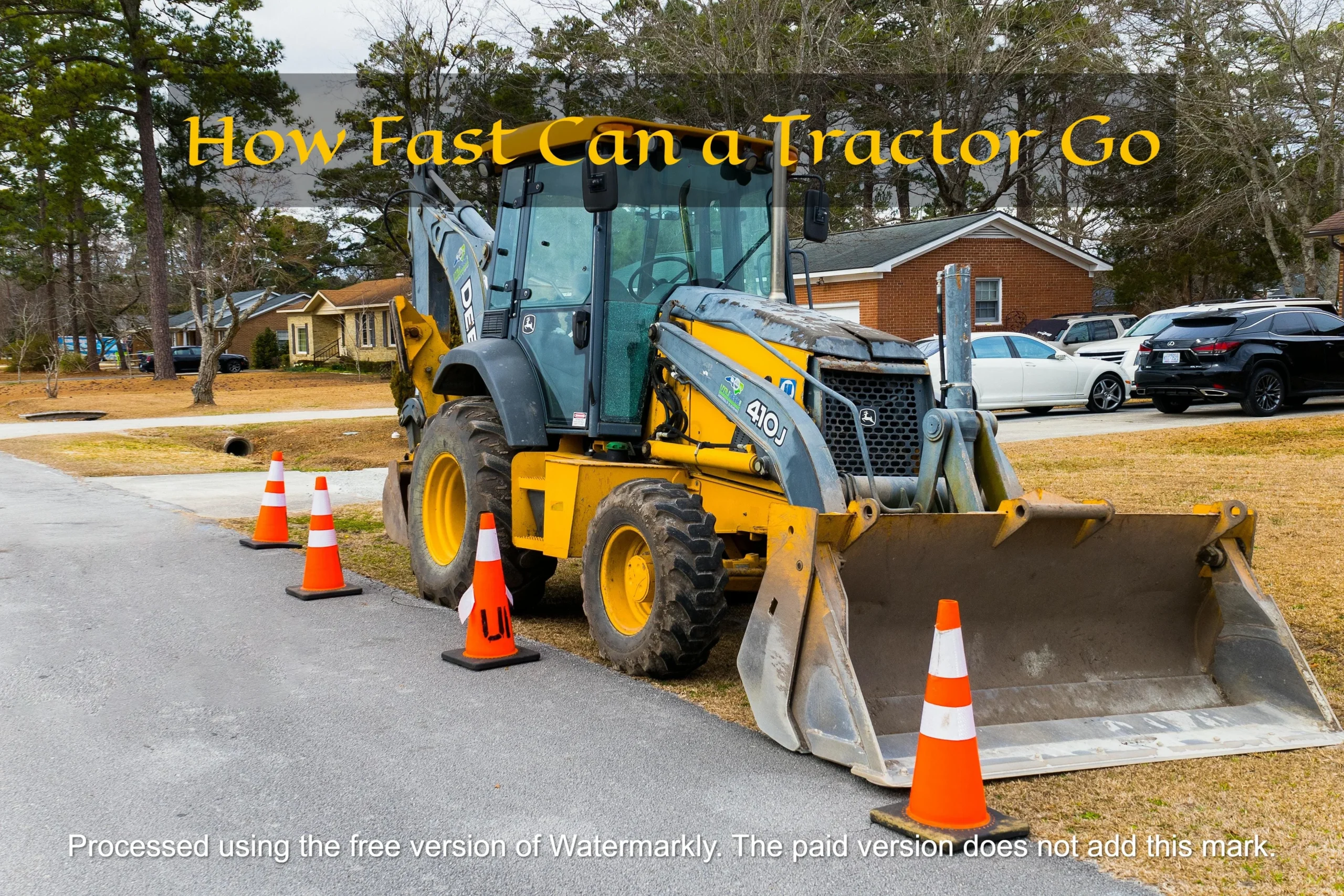How Fast Can a Tractor Go
A tractor’s top speed is influenced by factors like engine power, transmission, tire size, and terrain. While utility tractors may reach 15-25 mph, row-crop and high-horsepower tractors can go 20-35 mph. However, speed limits of 25-40 mph on public roads prioritize safety for these heavy agricultural vehicles.
Introduction
Tractors are essential pieces of equipment in the agricultural industry, playing a vital role in various farming operations. While these powerful machines are primarily designed for hauling, tilling, and planting, their speed capabilities have often piqued the curiosity of both farmers and enthusiasts alike. The question “How fast can a tractor go?” is a common one, and the answer may surprise you.
In this comprehensive article, we’ll delve into the intricacies of tractor speed, exploring factors that influence their maximum velocity, safety considerations, and the reasons behind speed limitations. Additionally, we’ll provide insights into the evolution of tractor technology, examining how advancements have impacted speed capabilities over time.

Factors Influencing Fast Can a Tractor Go
Engine Power and Gearing
The speed of a tractor is directly influenced by its engine power and gearing system. Larger and more powerful engines generally allow for higher top speeds, as they can generate more torque and horsepower. However, it’s essential to consider the intended purpose of the tractor, as excessive speed can compromise stability and control, particularly when hauling heavy loads or operating on uneven terrain.
Tire Size and Configuration
The size and configuration of a tractor’s tires play a crucial role in determining its maximum speed. Larger tires with a higher rolling radius can increase the tractor’s top speed, as they cover more ground with each revolution. Additionally, tractors equipped with dual rear tires or track systems may have different speed capabilities compared to those with single rear tires.
Transmission and Gear Ratios
Tractors typically feature multiple gears and transmission systems designed for different applications. Lower gears provide more torque for heavy-duty tasks, while higher gears allow for increased speed. The gear ratios and transmission design significantly impact the tractor’s speed range and potential top speed.
Terrain and Load Conditions
The terrain and load conditions under which a tractor operates can also affect its speed capabilities. Rough or uneven ground may necessitate slower speeds for safety and stability reasons, while hauling heavy loads or operating on steep inclines can limit the tractor’s ability to reach higher velocities.

Typical Tractor Speed Ranges
Tractor speed capabilities can vary widely depending on the specific model, manufacturer, and intended application. Here’s a general overview of the speed ranges for different types of tractors:
Utility Tractors
Utility tractors, typically used for light-duty tasks such as mowing, hauling, and light tillage, generally have top speeds ranging from 15 to 25 mph (24 to 40 km/h). These tractors prioritize maneuverability and versatility over outright speed.
Row-Crop Tractors
Row-crop tractors, designed for field operations like planting, cultivating, and harvesting, often have top speeds between 20 and 30 mph (32 to 48 km/h). This range allows for efficient fieldwork while maintaining stability and control.
High-Horsepower Tractors
High-horsepower tractors, used for heavy-duty applications like tillage, planting, and hauling, can reach top speeds of 25 to 35 mph (40 to 56 km/h). These powerful machines are built for productivity and efficiency, with speed capabilities that allow for faster field operations.
Specialized Tractors
Certain specialized tractors, such as articulated tractors used in vineyards or orchards, may have slower top speeds, typically ranging from 12 to 20 mph (19 to 32 km/h). These machines prioritize maneuverability and stability over outright speed due to their unique operating environments.
It’s important to note that actual tractor speeds can vary depending on factors such as terrain, load conditions, and operator preferences. Additionally, manufacturers may impose speed limiters or governed top speeds for safety and regulatory compliance reasons.
Safety Considerations and Speed Limits
While faster tractor speeds can improve productivity and efficiency, safety should always be the top priority. Excessive speeds can increase the risk of accidents, rollovers, and loss of control, particularly when operating on uneven terrain or carrying heavy loads.
Many countries and jurisdictions have implemented speed limits for agricultural machinery to ensure safe operation on public roads and highways. These speed limits typically range from 25 to 40 mph (40 to 64 km/h), depending on the specific regulations and vehicle classification.
Tractor manufacturers also incorporate speed limiters or governors to restrict the maximum attainable speed, ensuring compliance with safety standards and regulations. These electronic or mechanical systems prevent the tractor from exceeding a predetermined speed, regardless of the operator’s input.
Table: Typical Speed Limits for Tractors on Public Roads
| Country/Region | Speed Limit (mph) | Speed Limit (km/h) |
|---|---|---|
| United States | 25 | 40 |
| Canada | 25-40 | 40-64 |
| European Union | 25 | 40 |
| Australia | 25 | 40 |
| New Zealand | 30 | 48 |
It’s crucial for tractor operators to adhere to these speed limits and follow safe operating practices, such as maintaining control, using appropriate lighting and signaling devices, and being aware of surrounding traffic and road conditions.
The Evolution of Tractor Speed
As tractor technology has advanced over the years, manufacturers have focused on improving speed capabilities while maintaining safety and efficiency. Here’s a brief overview of how tractor speed has evolved:
Early Tractors (1900s-1940s)
Early tractors, such as the iconic Fordson Model F and John Deere Model D, were designed primarily for hauling and powering farm machinery. Their top speeds were typically limited to around 5 to 10 mph (8 to 16 km/h), reflecting the era’s focus on raw power and torque over outright speed.
Post-World War II Era (1950s-1970s)
As agriculture became more mechanized and industrialized in the post-war era, tractor manufacturers began to prioritize speed and efficiency. Tractors like the Farmall M and John Deere 4020 featured more powerful engines and improved transmissions, allowing for top speeds of 15 to 20 mph (24 to 32 km/h).
Modern Tractors (1980s-Present)
Modern tractors have benefited from significant technological advancements, including electronically controlled transmissions, powerful turbocharged engines, and advanced suspension systems. These improvements have enabled top speeds of 25 to 35 mph (40 to 56 km/h) for many high-horsepower and row-crop tractors, while maintaining stability and operator comfort.
Additionally, the advent of continuously variable transmissions (CVTs) and infinitely variable transmissions (IVTs) has further enhanced speed control and flexibility, allowing operators to precisely adjust the tractor’s speed for various applications.
Implications of Increased Tractor Speed
While faster tractor speeds can offer improved productivity and efficiency, they also present certain challenges and considerations:
Fuel Efficiency
Higher speeds generally result in increased fuel consumption, which can impact operating costs and environmental footprint. Manufacturers must strike a balance between speed capabilities and fuel efficiency to meet both performance and sustainability goals.
Operator Comfort and Safety
Faster speeds can increase vibrations, noise levels, and overall operator fatigue, potentially compromising safety and performance. Advancements in cab design, suspension systems, and ergonomics have helped mitigate these issues, allowing for comfortable and safe operation at higher speeds.
Field Operations and Precision Agriculture
Certain field operations, such as planting, spraying, or harvesting, may require slower speeds for optimal performance and precision. Manufacturers have developed specialized equipment and variable speed controls to accommodate these specific requirements.
Road Infrastructure and Regulations
Increasing tractor speeds on public roads may necessitate improvements in road infrastructure, signage, and safety regulations to accommodate these larger and faster vehicles. Ongoing collaboration between agricultural stakeholders and transportation authorities is essential to address these challenges.
Future Developments and Trends
As the agricultural industry continues to evolve, tractor manufacturers are exploring new technologies and concepts to further enhance speed capabilities while maintaining safety and efficiency. Some potential future developments and trends include:
Autonomous and Semi-Autonomous Tractors
The advent of autonomous and semi-autonomous tractors could revolutionize the way farmers approach field operations. These advanced systems could optimize speed and efficiency based on real-time data analysis, terrain conditions, and crop requirements, potentially increasing productivity while reducing operator fatigue and errors.
Electric and Hybrid Propulsion Systems
Electric and hybrid propulsion systems are gaining traction in the agricultural sector, offering potential benefits in terms of reduced emissions, lower operating costs, and improved torque characteristics. These systems could also enable new speed and performance capabilities tailored to specific applications.
Advanced Connectivity and Telematics
The integration of advanced connectivity and telematics systems in tractors
could enable remote monitoring and control, allowing for real-time adjustments to speed and performance based on field conditions, weather patterns, and operational requirements.
Precision Agriculture and Variable Rate Technology
The integration of precision agriculture technologies, such as variable rate application systems and GPS guidance, could further optimize tractor speeds for specific field operations. By precisely controlling input rates and application patterns, farmers can maximize efficiency while minimizing waste and environmental impact.
Tractor Speed Testing and Records
While most tractors are designed and governed for practical agricultural applications, a niche community of enthusiasts and engineers push the boundaries of tractor speed. These efforts have resulted in specialized speed-focused tractors and official record attempts.
The Tractor Speed Record
The current record for the world’s fastest tractor belongs to the “Speed Gem” built by JCB, a British manufacturer of construction and agricultural machinery. In 2019, the Speed Gem achieved a jaw-dropping top speed of 153.771 mph (247.47 km/h), shattering the previous record.
This purpose-built speed machine features a turbocharged diesel engine producing over 1,000 horsepower and a sleek, aerodynamic design more akin to a race car than a traditional tractor. The Speed Gem’s record-breaking run took place on a runway at Elvington Airfield in North Yorkshire, England.
Tractor Speed Competitions and Events
While the Speed Gem represents the pinnacle of tractor speed engineering, there are various competitions and events dedicated to high-speed tractor performance. These events attract enthusiasts, builders, and manufacturers who push the limits of what these machines can achieve.
One notable example is the Tractor Speed Competition held annually in Tulare, California. This event features multiple classes for different tractor types, with competitors vying for the fastest times over a measured distance. Strict safety protocols are in place, and tractors must undergo rigorous inspections to ensure compliance with competition rules.
Other events, such as tractor pulling competitions, also showcase the power and speed capabilities of heavily modified tractors, albeit over shorter distances and with a focus on raw pulling power rather than outright speed.
Tractor Speed Modifications and Customization
For those seeking to enhance the speed capabilities of their tractors, a thriving aftermarket industry offers a range of performance upgrades and modifications. However, it’s crucial to understand the legal and safety implications of such modifications, as well as the potential impacts on warranty coverage and regulatory compliance.
Engine Modifications
One common approach to increasing tractor speed is through engine modifications. This can involve upgrading to larger turbochargers, installing high-performance fuel injectors, or even completely swapping the engine for a more powerful unit. These modifications often require accompanying upgrades to the cooling system, exhaust, and other components to support the increased power output.
Transmission and Gearing Upgrades
Enhancing the tractor’s transmission and gearing system is another avenue for speed improvement. This may involve replacing the stock transmission with a higher-performance unit, adjusting gear ratios, or installing additional gear sets or overdrive units. These modifications can help the tractor take full advantage of the increased engine power while maintaining optimal operating ranges.
Aerodynamic Enhancements
For tractors intended for high-speed operation, aerodynamic improvements can play a significant role in reducing drag and increasing top speed potential. This may involve adding sleek bodywork, adjusting the tractor’s profile, or incorporating aerodynamic aids such as spoilers or air dams.
Suspension and Braking Upgrades
Upgrading the suspension and braking systems is crucial for maintaining control and stability at higher speeds. This can involve installing performance shocks and struts, adjusting suspension geometry, or upgrading to larger, more capable braking components.
It’s important to note that while these modifications can enhance a tractor’s speed capabilities, they may also void manufacturer warranties, impact safety and stability, and potentially violate local regulations or speed limits. Professional guidance and adherence to safety protocols are essential when pursuing such modifications.
Balancing Speed and Sustainability in Modern Agriculture
As the agricultural industry continues to evolve, there is an increasing focus on balancing productivity and efficiency with environmental sustainability and responsible resource management. This balance extends to the realm of tractor speed and performance.
Precision Agriculture and Targeted Input Application
Advances in precision agriculture technologies, such as variable rate application systems and GPS guidance, allow farmers to optimize input usage and minimize waste. By precisely controlling the application rates of seed, fertilizer, and crop protection products, farmers can achieve higher yields while reducing their environmental footprint.
Tractor speed plays a crucial role in precision agriculture, as optimal speeds are required to ensure accurate and consistent application rates across the field. Advanced control systems and continuously variable transmissions (CVTs) enable operators to precisely adjust tractor speeds to match field conditions and application requirements.
Soil Conservation and Erosion Control
Excessive tractor speeds, particularly in combination with heavy implements or adverse soil conditions, can contribute to soil compaction and erosion. These issues can have long-term impacts on soil fertility, water retention, and overall crop productivity.
Modern tractor designs and operating practices aim to mitigate these risks through features like low ground pressure tires, weight distribution systems, and controlled traffic farming (CTF) techniques. By optimizing tractor speed and minimizing unnecessary passes over the field, farmers can reduce soil disturbance and preserve valuable topsoil.
Fuel Efficiency and Emissions Reduction
As concerns over greenhouse gas emissions and climate change continue to grow, the agricultural industry is actively exploring ways to improve fuel efficiency and reduce its carbon footprint. Tractor manufacturers are implementing advanced engine technologies, such as exhaust gas recirculation (EGR) and selective catalytic reduction (SCR) systems, to meet stricter emissions regulations.
Optimizing tractor speed and operating patterns can also contribute to improved fuel efficiency and reduced emissions. Precise speed control, load management, and route planning can minimize unnecessary idling, excessive RPMs, and inefficient operation, resulting in lower fuel consumption and reduced emissions per unit of work performed.
By striking a balance between speed, productivity, and environmental stewardship, the agricultural industry can continue to meet the growing demand for food and resources while promoting sustainable practices for future generations.
Conclusion
The question “How fast can a tractor go?” is a complex one, with the answer depending on various factors such as engine power, transmission design, tire configuration, terrain conditions, and intended application. While modern tractors have seen significant improvements in speed capabilities, safety remains the top priority, with speed limits and regulations in place to ensure responsible operation.
As technology continues to advance, we can expect further developments in areas such as autonomous control, electric propulsion, and precision agriculture, all of which may reshape our understanding of tractor speed and performance. However, the core purpose of tractors as efficient and versatile agricultural machinery will endure, striking a balance between speed, productivity, and sustainable farming practices.
Ultimately, the speed of a tractor is a tool to be utilized responsibly, enabling farmers to maximize efficiency while prioritizing safety, environmental stewardship, and the long-term sustainability of the agricultural industry.
FAQs
1. What is the fastest tractor in the world?
While exact figures may vary, some of the fastest tractors in the world are purpose-built for tractor pulling competitions or speed records. These specialized machines can reach top speeds upwards of 70 mph (112 km/h), thanks to highly modified engines, lightweight construction, and optimized gearing systems.
2. Can a tractor go faster than a car on the road?
No, most tractors are not designed to go faster than typical passenger cars on public roads. Tractors are limited by speed restrictions, safety considerations, and their intended purpose as agricultural machinery. Most tractors have a governed top speed of around 25-35 mph (40-56 km/h) for safe operation on roads.
3. How does tractor speed affect fuel efficiency?
Higher tractor speeds generally result in increased fuel consumption, as more power is required to overcome wind resistance and maintain the higher velocity. However, modern tractors with advanced transmissions and engine management systems can optimize fuel efficiency at different speeds, minimizing the impact of increased speed on fuel economy.
4. Can tractor speed be adjusted for different field operations?
Yes, many modern tractors feature adjustable speed settings or transmission modes tailored for specific field operations. For example, lower speeds may be optimal for precision planting or harvesting, while higher speeds are preferred for tillage or transportation between fields. Operators can adjust the tractor’s speed range to suit the task at hand.
5. What safety features are incorporated into tractors to ensure stability at higher speeds?
Tractor manufacturers incorporate various safety features to maintain stability and control at higher speeds, such as:
- Improved suspension systems: Advanced suspension designs help absorb shocks and maintain traction, improving stability on uneven terrain.
- Anti-lock braking systems (ABS): ABS prevents wheel lockup during braking, allowing for better control and shorter stopping distances.
- Roll-over protective structures (ROPS): ROPS provide a protective cage or frame to shield the operator in the event of a rollover accident.
- Electronic stability control (ESC): ESC systems monitor and adjust tractor dynamics to prevent skidding or rollovers in critical situations.
https://tractortrend.com/?p=788






